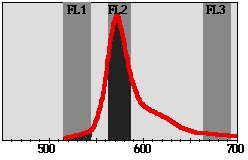
(Go back one page to one-way compensation,
or back to the introduction)
Two-way compensation (correction for two fluors) is really a simple extension
of the one-way compensation noted above. Continuing our example... we collected
a fluorescein-only sample to calculate how much spillover there is between
FL1 and FL2 for fluorescein. Now we will collect a PE-only sample to calculate
how much spillover there is between FL2 and FL1 for PE!

For the PE-only sample, we compute the ratio of the area under the curve
in the FL2 band to that in the FL1 band. Typically, this ratio in FACS experiments
might be 1%.
Therefore: 15% of the fluorescein signal in FL1 comes out in FL2; 1% of
the PE signal in FL2 comes out in FL1. What happens if both fluorescein
and PE are present simultaneously? "Miraculously", the math still
works. An example will show how it works.
Otherwise, you can go to the three-color section.